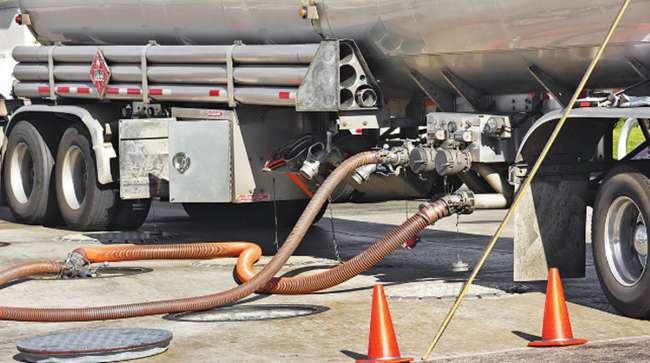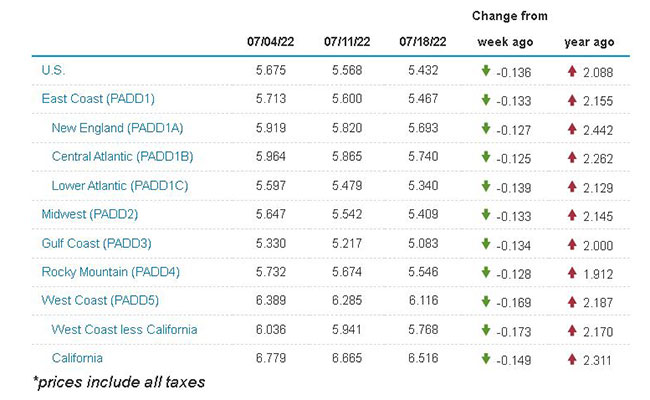Senior Reporter
Diesel Plunges 13.6¢ to Settle at $5.432 a Gallon

[Stay on top of transportation news: Get TTNews in your inbox.]
The national average price of diesel fell for the fourth consecutive week — and by at least a dime for the third straight time — by 13.6 cents to settle at $5.432 a gallon, according to Energy Information Administration data released July 18.
Diesel’s cost has plunged 37.8 cents a gallon since it reached a record $5.810 on June 20.
Trucking’s main fuel still costs $2.088 more for a gallon than it did at this time in 2021.
Diesel’s price dropped in all 10 regions surveyed by EIA, with 17.3 cents in the West Coast (less California) region being the largest and 12.5 cents in the Central Atlantic the smallest.
Gasoline is now closer to $4 than $5, dropping by 15.6 cents nationally to stick at $4.49 a gallon.
Gasoline is used in 23% of commercial trucking, experts said, and 97% of all Class 8 vehicles run on diesel.
A drop in the number of U.S. refineries (compared with before the pandemic) has contributed to the rising fuel prices.
U.S. On-Highway Diesel Fuel Prices

EIA.gov
Now, a little good news is emerging.
“Although no projects to build new refineries in the United States are currently planned, major refinery expansions are underway at a handful of Gulf Coast refineries, most notably ExxonMobil’s Beaumont, Texas, refinery, which plans to increase its capacity by 250,000 barrels per day by 2023,” EIA reported.
Gulf Coast facilities account for 54% of all U.S. domestic refining capacity, according to EIA — but they are also substantial exporters into the Atlantic basin market, particularly into Central and South America and also into Europe.
Brad Hicks, president of highway services at J.B. Hunt Transport Services, in a recent earnings call noted fuel costs were a pass-through for the carrier.
“We don’t report operating ratio or margin net of fuel surcharge like some others in the industry, but [fuel] was a headwind to margin — at least 100-basis-point headwind to margin percent on a year-over-year basis [in the second quarter]. We also looked at it on a sequential basis,” Hicks said. “And you would have seen a decent amount of margin improvement sequentially if you excluded the impact of fuel.”
And diesel is not going away soon, but efforts are underway to make it cleaner and renewable.
Right now it is not possible to replace 100% of traditional diesel with renewable diesel, as “we’d run out of feedstock,” said Adam Schubert, a researcher at Stillwater Associates, during a recent webinar.
Renewable diesel is made of renewable resources such as natural fats, vegetable oils, and greases and its physical properties are similar to those of petroleum diesel.
“However,” he said, “what you can do is make a very substantial displacement in the urban areas with the highest concentration of ozone and particulate matter, and so make the biggest difference where the vast majority of the population lives.”

There are many reasons for trucking's ongoing labor shortage. We recap discussions from the first half of this year in this "roundabout" episode. Tune in above or by going to RoadSigns.TTNews.com.
One study found U.S. biodiesel and renewable diesel production generates a 4% decrease in the price of diesel fuel.
EIA reported distillate fuel product supplied — an indication of demand — averaged 3.8 million barrels a day over the four weeks ending July 15, down by 0.6% compared with the same period last year.
The West Texas Intermediate futures price on July 19 was $104.22 per barrel, $8.38 higher compared with a week earlier and $37.80 compared with a year earlier.
Crude has fluctuated around $100 a barrel with traders weighing demand impacts from a potential recession with a weakening dollar and a pipeline outage that has tightened the U.S. market, Bloomberg News reported.
Meanwhile, the latest Cowen/AFS Freight Index showed fuel is once again a major driver of dramatic cost-per-shipment growth, with the second-quarter index for less-than-truckload turning out to be even higher than the April release predicted.
Among major LTL carriers, the average fuel surcharge increased in the second quarter to 47.6% from 34% in the first quarter. Fuel accounts for 20.7% of the total cost-per-pound for LTL shipments through June 2022, up from 13.4% in 2021 — a 47.3% increase, according to the index.
According to the index, “Parcel fuel surcharges continued to rise in Q2 2022, tripling for express parcel and more than doubling for ground parcel on a year-over-year basis. FedEx Corp. and UPS Inc. leveraged fuel surcharges as significant profit drivers, adjusting fuel surcharge tables twice since late 2021, with increases that continue to outpace corresponding indices from EIA on which they are based.”
Want more news? Listen to today's daily briefing below or go here for more info:




